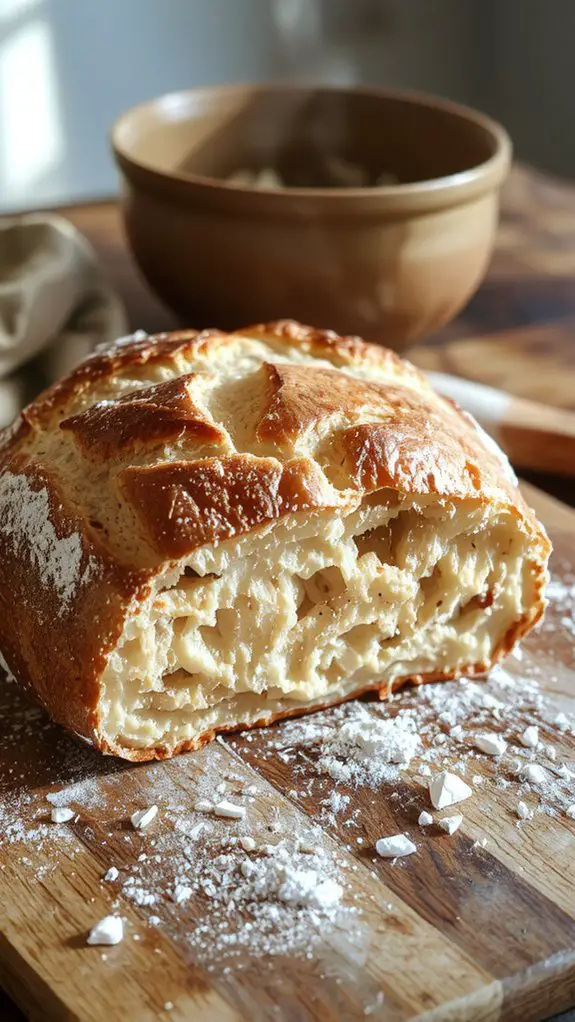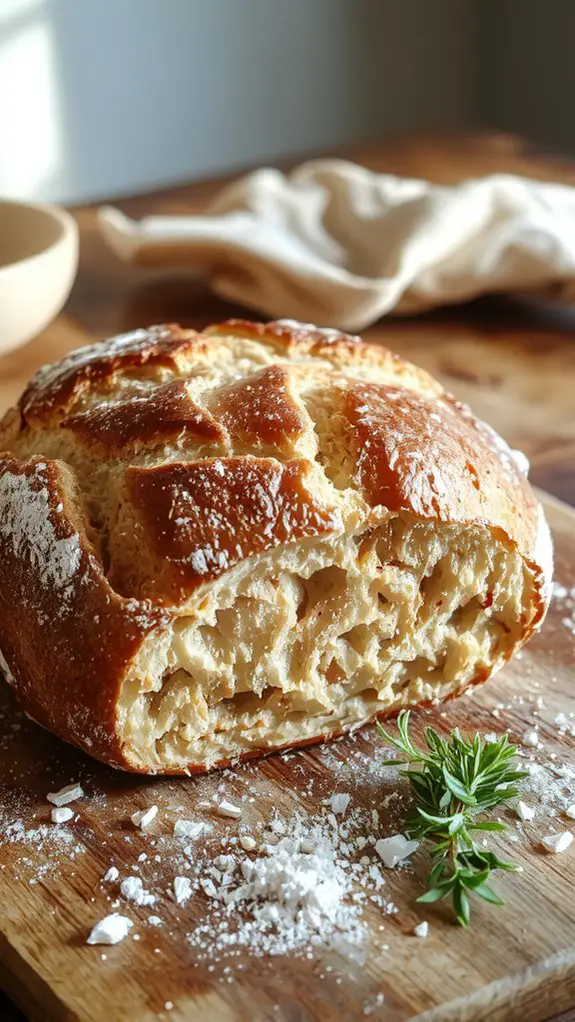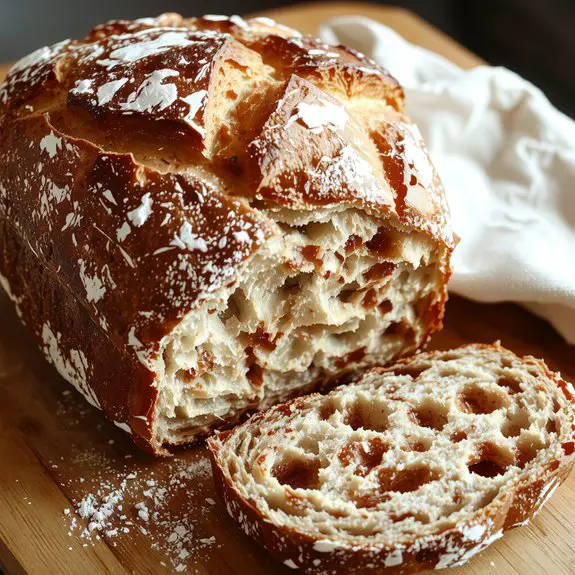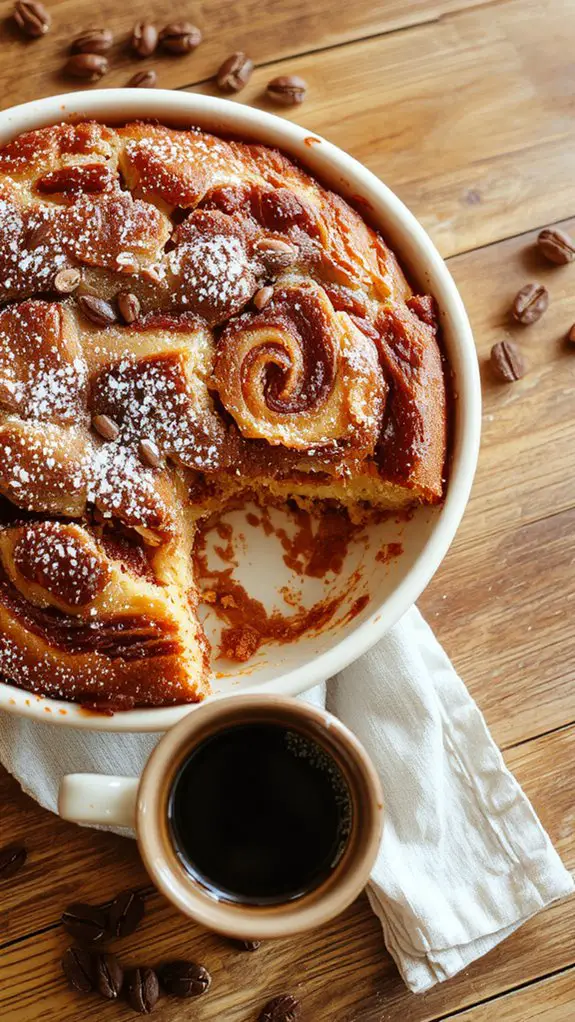Recipe
There’s something magical about a loaf of sourdough—crackling crust, chewy interior, and that tangy depth of flavor you just can’t get from store-bought bread. This recipe? It’s the real deal. No shortcuts, no fuss—just flour, water, salt, and time working their alchemy.
I’ve baked this loaf more times than I can count, and trust me, once you nail it, you’ll never go back. The secret? A lively, bubbly starter (your kitchen’s new best friend) and the patience to let the dough develop its full character.
Imagine pulling a golden, blistered loaf from the oven, the scent filling your kitchen, that first bite revealing a soft, airy crumb with just the right amount of chew. It’s worth every minute.
Ready to bake bread that’ll make you proud? Let’s do this.
Ingredients
Making sourdough bread at home is a rewarding process, and the quality of your ingredients can make or break your loaf. Here’s everything you’ll need to create a crusty, tangy masterpiece. Pay attention to the details—they’re what separate a good loaf from a great one.
- Active Sourdough Starter: The heart of your bread. Make sure it’s bubbly and active—if it hasn’t been fed in a while, refresh it 4-6 hours before baking.
- Bread Flour (500g): High protein content (12-14%) is essential for that chewy, open crumb. If you don’t have bread flour, all-purpose flour works, but the texture won’t be as robust.
- Water (350g, lukewarm): Room temperature or slightly warm water helps activate the starter. Filtered or bottled water is best if your tap water is heavily chlorinated.
- Salt (10g): Fine sea salt is ideal—it enhances flavor and strengthens the dough. Don’t skip it, as it balances the tang and improves structure.
- Optional: Whole Grain Flour (50g): For added depth of flavor and a nutty texture. Rye or spelt flour are great options if you’re feeling adventurous.
- Optional: Rice Flour (for dusting): While not essential, rice flour prevents the dough from sticking to the banneton (proofing basket) and gives your loaf a professional finish.
Pro Tip: Weigh your ingredients with a kitchen scale—accuracy is key in baking.
And if your starter is sluggish, try feeding it with whole grain flour for a boost of activity.
How to Make the Best Classic Sourdough Bread Recipe

- Cold proof overnight (8-12 hours) in the fridge. *Why:* This deepens flavor and makes scoring easier.
- Preheat oven to 475°F (245°C) with a Dutch inside for 45 minutes.
*Flexibility:* No Dutch oven? Use a baking stone with steam from a tray of ice.
– Score and bake by turning dough onto parchment, slashing the top, and transferring to the hot Dutch oven.
Bake covered for 20 minutes, then uncovered for 20-25 minutes until deep golden.
*Visual cue:* Internal temp should read 208-210°F (98-99°C).
– Cool completely on a wire rack for 2+ hours.
*Watch out:* Cutting too soon releases steam and dries out the crumb.
Nutrition
Sourdough bread offers a nutritious option compared to many commercial breads. Here’s a breakdown of its nutritional value per 100g serving:
| Nutrient | Amount |
|---|---|
| Calories | 235 kcal |
| Carbohydrates | 47 g |
| Protein | 8 g |
| Fat | 1 g |
| Fiber | 3 g |
| Sugar | 1 g |
| Sodium | 400 mg |
Chef Tips
Perfecting sourdough takes a bit of practice, but I’ve picked up some techniques that make a big difference. Always feed your starter regularly and check its rise before baking.
Use a kitchen scale for precise measurements. Don’t skip the stretch-and-folds; they build structure.
Bake in a preheated Dutch oven for a crisp crust. Finally, trust the process—patience is key to great sourdough.
Frequently Asked Questions
How Do I Store Sourdough Starter?
I store my sourdough starter in a jar with a loose lid in the fridge between bakes. If I’m not baking often, I feed it weekly; if I am, I keep it at room temperature and feed daily.
Can I Use Tap Water for Sourdough?
I can use tap water for my sourdough if it’s safe to drink, but chlorine or chemicals might affect the starter. I prefer to let it sit out overnight to evaporate additives or use filtered water.
What if My Dough Doesn’T Rise?
If my dough doesn’t rise, I’ll check if my starter’s active by seeing if it floats in water. Maybe the room’s too cold—I’ll move it somewhere warmer or give it extra time.
How to Fix Overproofed Sourdough?
If I’ve overproofed my dough, I gently deflate it to remove excess gas, reshape it, and let it proof again for a shorter time. I’ll keep a closer eye to make certain it doesn’t overproof twice.
Can I Make Sourdough Gluten-Free?
I can make gluten-free sourdough by using a gluten-free flour blend and a gluten-free starter. It’s not traditional, but I adjust hydration and proofing times to mimic the texture and rise of regular sourdough.










